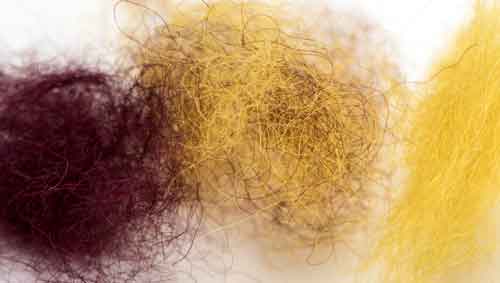Alpaca wool, processed and dyed. Processing wool means washing or scouring, which is very aggressive and thorough washing to remove grease, dirt and the rest (burrs, muck, stones, dust, sticks, seeds, etc) Processing wool can include treatment with strong acids and alkalis – ending up with a roll of dry, off-white fibre ready for dyeing and/or spinning.

Vicuna dubbing contains no contaminants, no bits of organic stuff, no grease, and the colour is obviously regular. My guess is the basic fibre was prepared for industrial dyeing and spinning, and diverted to our purposes.
The staple length for Alpaca wool is long, two or three times the length of typical sheep’s wool, up to six inches. Alpaca fibre is fine and smooth – finer, smoother and (therefore) softer than most types of sheep’s wool. (Also a better insulator than sheep’s wool – though I doubt that’s relevant.)
So, to make the prepared and processed fibre into dubbing – dye the fibre using standard acid dyes – cut the fibre to a staple length suitable for dubbing, and mix the fibres. (The order of those tasks can vary, and how each is achieved can also vary.)
Dyeing – these colours are good. The fibre is well dyed, clean and accurate colours. I’d suggest the palate of colours is missing a few, eg, dark claret, and some of the darker olives, however it should be easy enough to add those if there is a need/market.
The staple length is slightly surprising. I’d class this as a medium dubbing and use it as a seal substitute, but the staple length of this dubbing is significantly shorter than seal. That said, I can tease out a pinch of Vicuna Dubbing and get it on to a thread without a lot of short bits falling out. It twists onto thread pretty well, making a slim, sparse dubbing noodle; I find it a little harder to thicken up the dubbing noodle. Personally, I think the staple length is OK, but could be a little longer.
Mixing is good. These are all single colours, the fibres in a packet are all one colour at nicely random orientations. As a first generation of dubbing this stuff is well prepared and presented. Incidentally, Vicuna Dubbing mixes well using simple hand-stacking to blend two (or more) colours.
As mentioned I’d use this as a seal substitute, in fact it handles and ties pretty much like seal. Most natural fibre seal substitutes (and some synthetics) have long staple lengths which makes them hard to tie with – they tend to slip off thread, and don’t give that spiky fuzz of fibre ends we want – the shorter staple of this dubbing guarantees that fuzzy outline!
Among the best seal substitutes that I have tried, Vicuna Dubbing is a good new natural dubbing.
April 2019 issue



